
Asaphodes aegrota is a species of moth in the family Geometridae. It was first described by Arthur Gardiner Butler in 1879 as Selidosema aegrota. It is endemic to New Zealand and can be found in the North, South and Stewart Islands. This species inhabits open spaces in lowland native forest. The larvae of A. aegrota feed on native herbs and have also been observed feeding of the introduced lawn daisy. The adults are variable in appearance with the markings on both sides of its wings varying in intensity. Some populations also have narrow winged females. Adults are on the wing from November until March.

Helastia cinerearia is a moth of the family Geometridae. It is endemic to New Zealand and can be found in the North, South and Stewart Islands as well as on the Mercury and Chatham Islands. The preferred habitat of H. cinerearia includes urban gardens, various types of forest and sub alpine habitats. The larval host is lichen on rocks. The adult moths are on the wing all year round but are most commonly observed from September until February. Adult moths are nocturnal and have been observed feeding from and likely pollinating Hebe salicifolia, Hoheria lyallii and Leptospermum scoparium.

Asaphodes adonis is a species of moth in the family Geometridae. It is endemic to the South Island of New Zealand. It is found in native forest at altitudes of between 300 and 1200 metres. Larvae have been reared on species of Ranunculus. Adults are on the wing in January and February.

Asaphodes beata is a species of moth in the family Geometridae. It is endemic to New Zealand and is a relatively common species that can be found throughout the country in native forest or scrub habitat. It can be distinguished from its close relative Asaphodes adonis by the colour of its hind wings. The larvae of this species feeds on watercress but tends to be inactive during the day. If threatened it will mimic a twig dropping to the ground. The adult moths are on the wing from October to March and are said to be attracted to white rātā. The white markings on the forewing of the adults are variable in appearance.
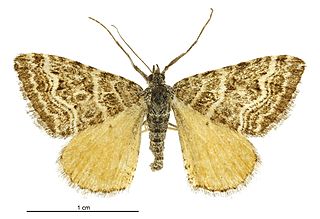
Xanthorhoe bulbulata is a species of moth in the family Geometridae. It is endemic to New Zealand. It is classified as critically endangered by the Department of Conservation.

Asaphodes chlamydota is a moth in the family Geometridae. It is endemic to New Zealand, and can be found in the lower part of the North Island and in the South Island. It inhabits native forest and shrublands. The larvae of this species feeds on native Clematis plants including Clematis afoliata. Adults are on the wing from November to April and are regarded as having intermedia flight powers.

Xanthorhoe orophyla is a moth of the family Geometridae. It is endemic to New Zealand and is found in the South Island in alpine habitat. This species has one brood a year and their larvae feed on cruciferous plants. Adults are on the wing from December to February and are attracted to light.

Asaphodes chlorocapna is a species of moth in the family Geometridae. This species is endemic to New Zealand and can only be found in the Chatham Islands. The larvae of this species consume the leaves of Muehlenbeckia plants. Adults are on the wing in January. This species is classified as "At Risk, Relict'" by the Department of Conservation.

Helastia clandestina is a moth of the family Geometridae. This species is endemic to New Zealand and is found only in the South Island in and around Arthur's Pass. Adults have been collected on the wing in February and are nocturnal. Its preferred habitat is dry stony riverbeds and flood plains. The glossy blueish grey colouration of the adults of this species helps camouflage them against the rocks in their preferred habitat. H. clandestina is classified as having the conservation status of "At Risk, Relict'" by the Department of Conservation.
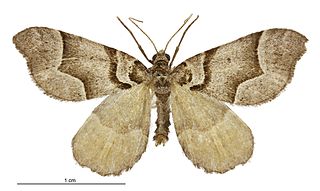
Helastia siris is a moth of the family Geometridae. This species is endemic to New Zealand. It is classified as "At Risk, Relict'" by the Department of Conservation.

Asaphodes declarata is a species of moth in the family Geometridae. This species is endemic to New Zealand and has been observed in the southern parts of the South Island. This species prefers open tussock grassland habitat amounts beech forest and in mountainous terrain. It can be found at altitudes of between 450 and 1750 m. The adults of this species are on the wing from November to March. The moths can vary both in size and, with the female of the species, in markings.
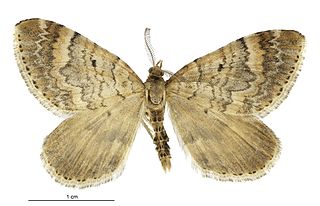
Asaphodes dionysias is a species of moth in the family Geometridae. This species is endemic to New Zealand and is only known from mountainous areas in Central Otago. It lives in open grassy mountainous habitat at altitudes up to 1750 m. It is also known to live in wetland habitat. The larvae of this species feed on native herbs. The adults of this species are on the wing in January and February. The adult female of the species has reduced wing size in comparison to the male.

Asaphodes glaciata is a species of moth in the family Geometridae. This species is endemic to New Zealand. This moth has only be found in Westland in the areas near Fox and Franz Josef Glaciers. Adults of this species are on the wing in January.
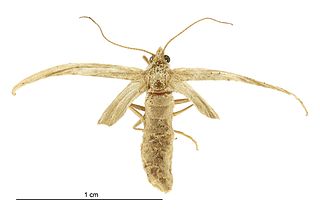
Asaphodes oraria is a species of moth in the family Geometridae. This species is endemic to New Zealand and has been observed in the southern South Island and on Stewart Island / Rakiura. The male is pale yellow coloured and the female has severely reduced wings and is flightless. The habitat of this species is tussock grasslands on coastal sand dunes and in the mountains at elevations of approximately 4,000 ft. The larvae have adapted to feeding on exotic lawn daisy species in the genus Bellis. The adults of this species are on the wing from November to April.

Asaphodes philpotti is a moth in the family Geometridae. It is endemic to New Zealand and has been found in the South Island as well as one observation in Wainuiomata in the North Island. This species inhabits native forest and larvae are hosted by species in the genera Hydrocotyle and Cardamine.

Asaphodes recta is a moth in the family Geometridae. It is endemic to New Zealand and is found in the southern parts of the South Island. The preferred habitat of this species is open tussock grassland. The adults are on the wing in February and March. Larvae of this species have been reared on species in the genera Ranunculus and Bellis.

Asaphodes sericodes is a moth in the family Geometridae. It is endemic to New Zealand and has been observed in the southern parts of the South Island. This species inhabits open tussock grasslands in subalpine scrub or wetlands. The female of the species is likely semi-apterous and is flightless. The adult males are on the wing in January.
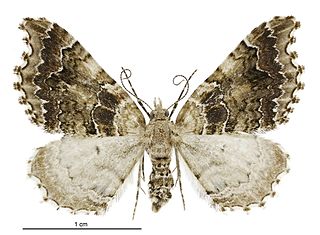
Helastia cymozeucta is a moth of the family Geometridae. It was first described by Edward Meyrick in 1913. This species is endemic to New Zealand and is found in both the North and the upper parts of the South Island. The adults of this species have been observed on the wing from November to January as well as in March.

Helastia farinata is a moth of the family Geometridae. It was first described by William Warren in 1896. This species is endemic to New Zealand and is found in the North Island. H. farinata inhabits shady and damp forest ravines.

Xanthorhoe orophylloides is a moth of the family Geometridae. It was first described by George Hudson in 1909 and is endemic to New Zealand. This species is found in the subantarctic islands including at the Auckland Islands and at Campbell Island.























